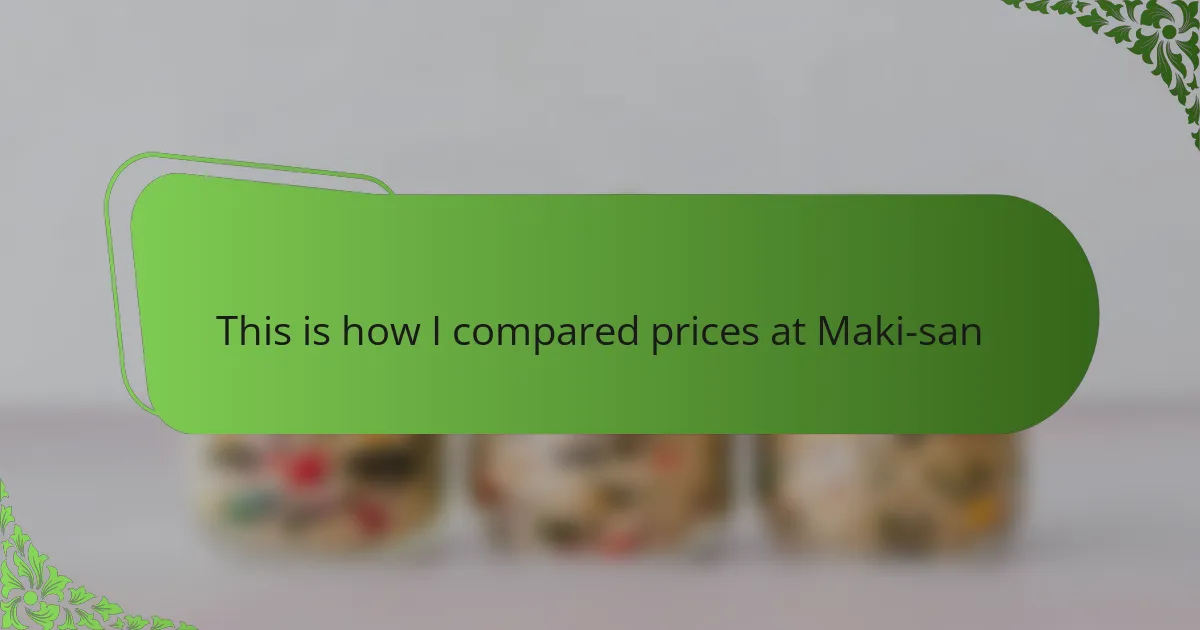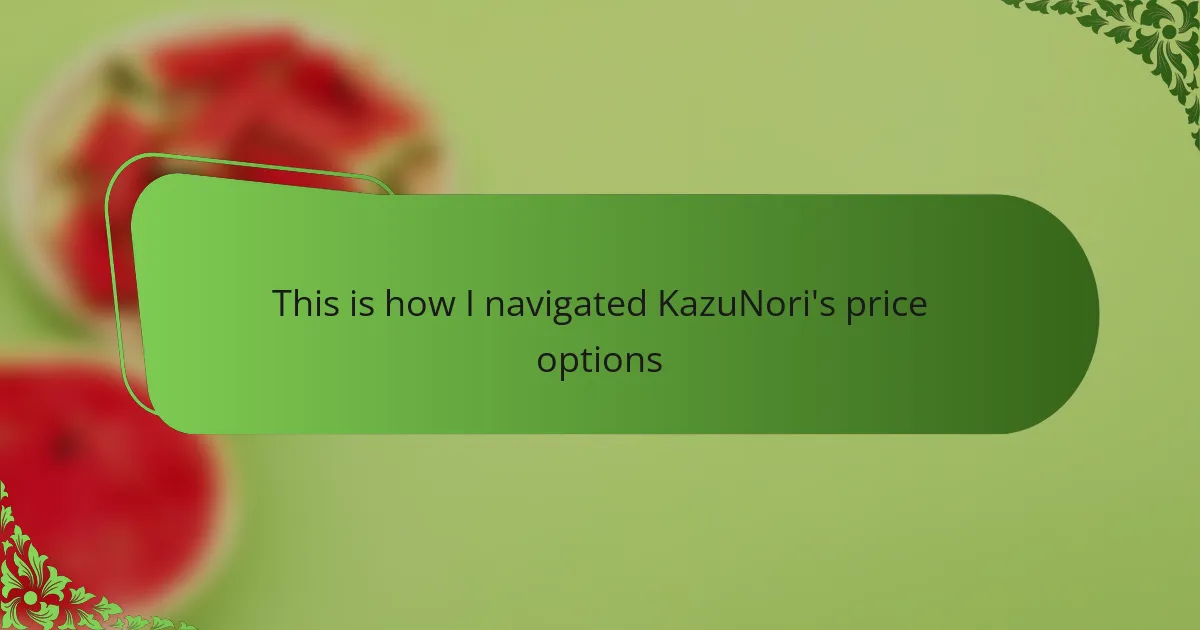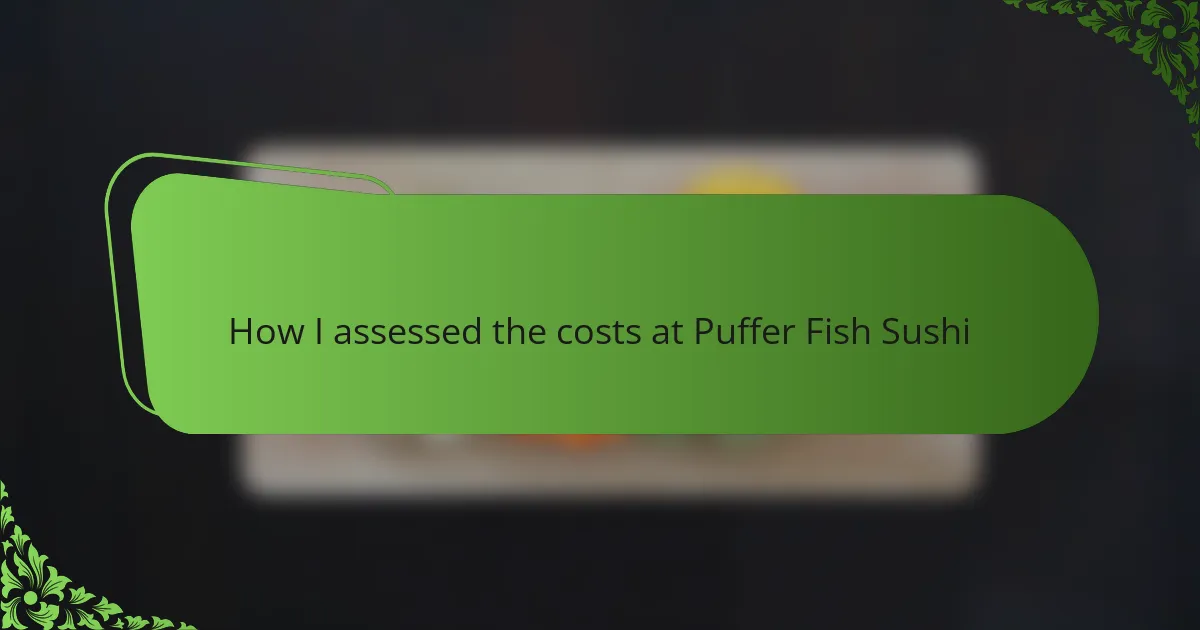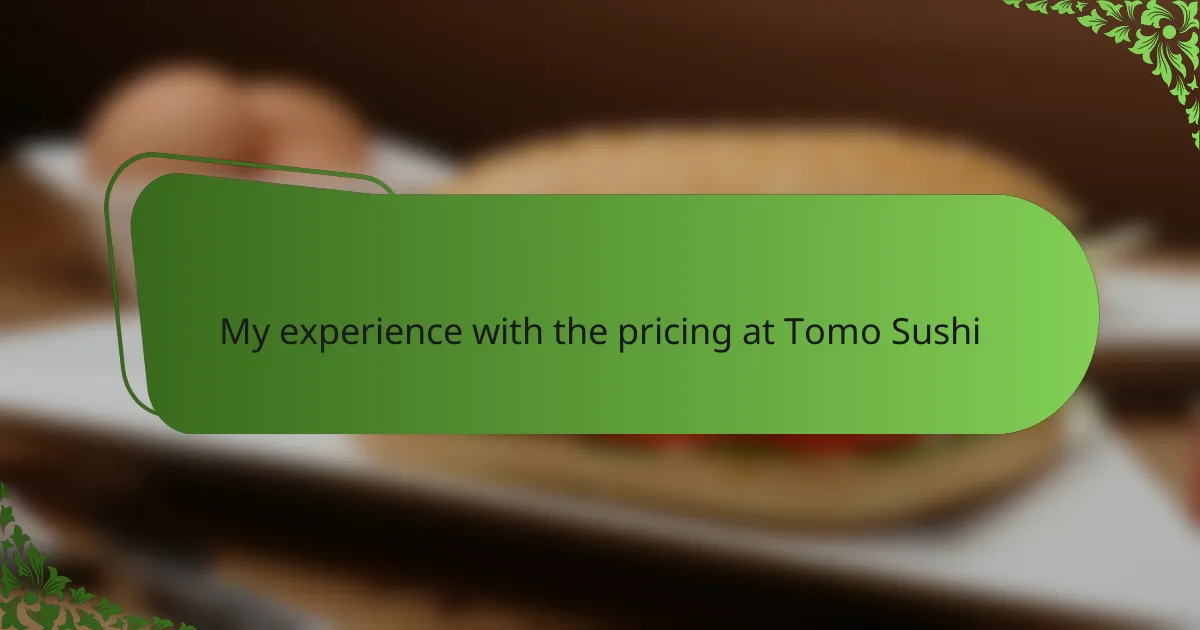Key takeaways
- Sushi pricing reflects the quality of ingredients and the skill involved in preparation, with factors such as fish type and restaurant environment impacting costs.
- When comparing prices, consider portion sizes, ingredient quality, and read reviews to assess value beyond just numbers.
- Utilizing tools like spreadsheets, apps, and online resources can help in effectively comparing prices across different sushi locations.
- To find the best deals, look for daily specials, ask about hidden promotions, and consider sharing dishes with friends for a cost-effective experience.
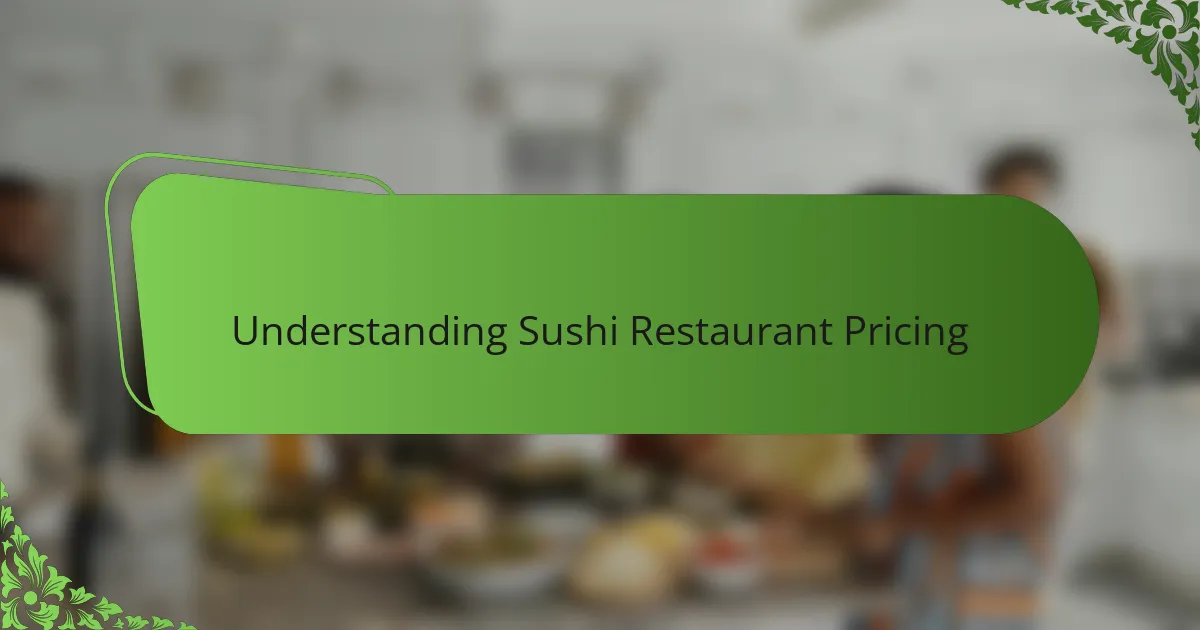
Understanding sushi restaurant pricing
When I first started exploring sushi restaurants, I quickly realized prices aren’t just numbers—they reflect the quality of ingredients and the skill behind each roll. Have you ever wondered why some places charge more for seemingly similar dishes? It’s often about sourcing fresh fish and craftsmanship, not just menu design.
Pricing can feel confusing, especially when you see a variety of sushi options with different price points. In my experience, understanding these differences helped me appreciate what I was paying for, whether it was premium cuts or the artistry of hand-rolled nigiri. It made me more confident about matching price to value rather than guessing.
Sushi restaurant pricing also depends on the dining experience itself. Are you at a fast-casual spot or a chef’s counter where every piece is made to order? Recognizing these nuances changed how I approached my budget and expectations, making each meal feel more meaningful rather than just a transaction.
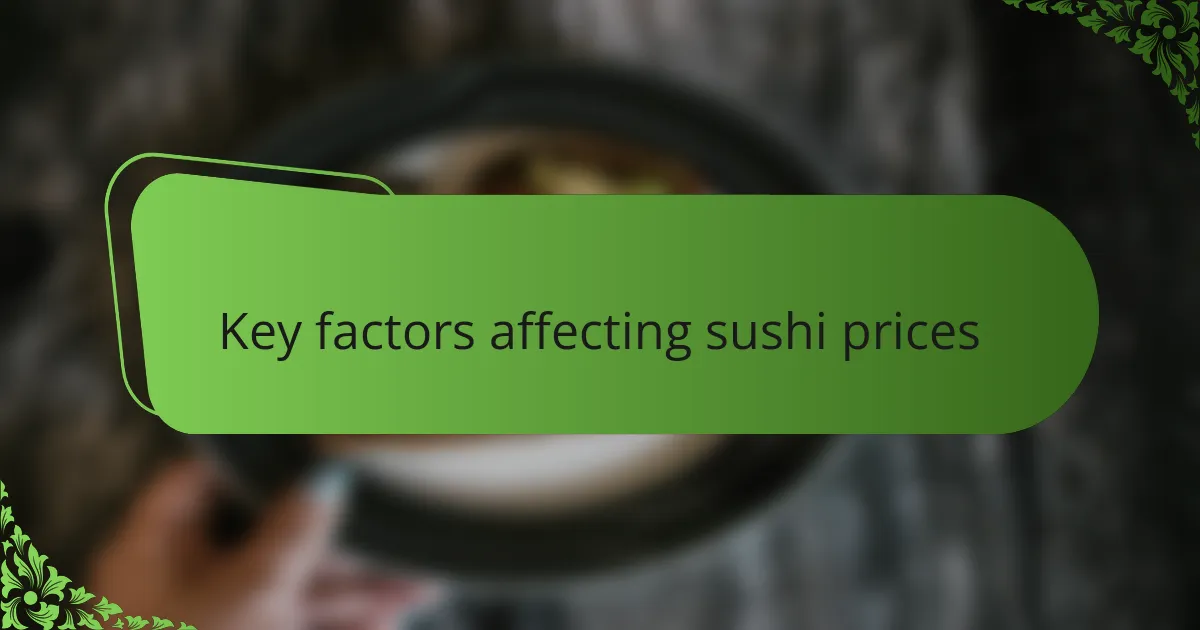
Key factors affecting sushi prices
One thing I noticed right away is that the type of fish used can drastically change the price. Have you ever looked closely at a menu and wondered why toro costs so much more than salmon? From my experience, the rarity and freshness of the fish play a huge role—it’s like paying for a little piece of the ocean’s finest.
Another factor is how sushi is prepared. When I sat at the chef’s counter once, watching the chef expertly slice and shape each piece, it was clear that skill adds value. Does the price reflect just the ingredients, or also the craftsmanship? I’d argue it’s both; skilled hands bring out flavors in a way a machine simply can’t replicate.
Lastly, the type of restaurant environment matters more than we realize. Casual spots might offer great sushi at lower prices, but I found that high-end places often include ambiance, presentation, and even personalized service in their costs. Have you ever felt the difference between grabbing sushi to go and enjoying it in a serene setting? For me, that experience is definitely worth a few extra dollars.
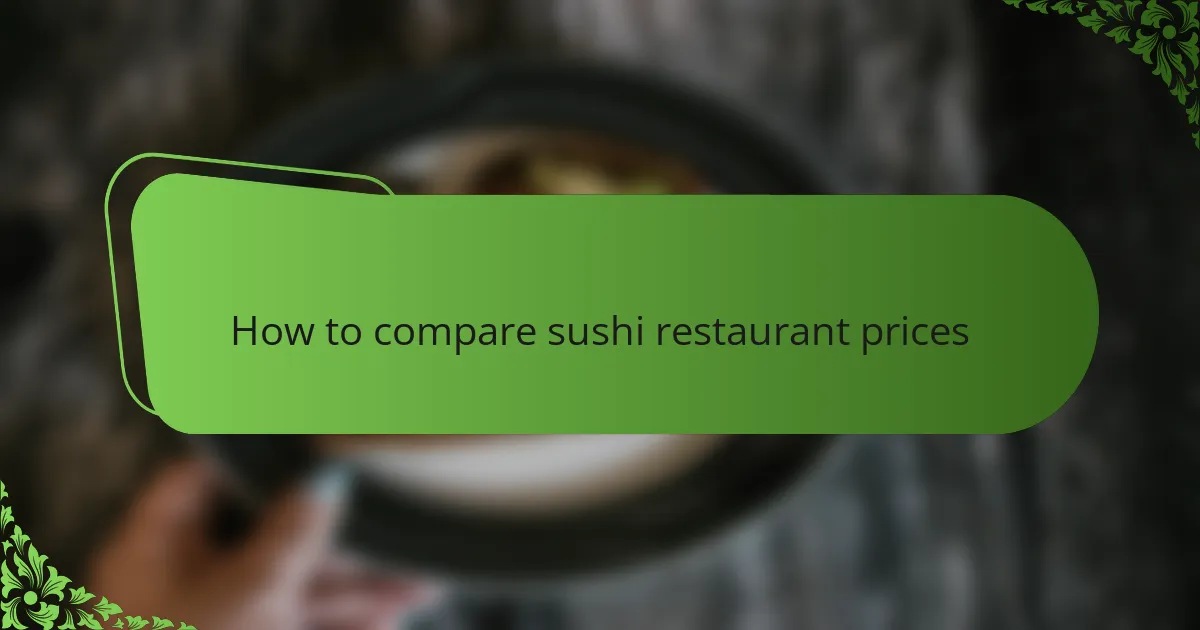
How to compare sushi restaurant prices
When I started comparing sushi prices, the first thing I did was break down the menu into categories—like rolls, nigiri, and sashimi—and noted the price ranges for each. Have you ever tried listing out prices side by side? It really helped me spot where a restaurant might be charging more for similar items.
I also paid close attention to portion sizes and ingredient descriptions. For example, one place offered a “special” roll packed with premium fish but was priced only slightly higher than a basic roll elsewhere. That made me wonder: was I really getting extra value or just a fancy name? Comparing these details gave me a clearer sense of what I was actually paying for.
Another trick I found useful was reading online reviews that mention value for money. Sometimes the menu alone doesn’t tell the full story about freshness or quality. By combining price comparison with customer feedback, I could better judge whether a restaurant’s prices matched the experience and taste they promised. Have you ever relied on others’ opinions to make smarter dining choices? For me, it’s been a game changer.

Tools for price comparison
One tool I found incredibly helpful was creating a simple spreadsheet where I logged prices from different Maki-san locations. It felt a bit like detective work, but seeing all the numbers laid out helped me spot patterns and outliers that I might have missed just by glancing at menus. Have you ever tried organizing information this way? It really puts things into perspective.
I also used mobile apps that specialize in restaurant comparisons; some even allowed me to filter by dish type or average price. In my experience, these apps saved time and gave me a quick snapshot without needing to hop between websites. But of course, I always double-checked their data because nothing beats firsthand verification.
Lastly, I leaned on social media and food blogs where sushi fans share their finds and price hacks. Reading real stories of what people paid and how they felt about it added a layer of insight that numbers alone can’t provide. Have you noticed how personal reviews often reveal hidden gems or cautionary tales? For me, those voices were invaluable in putting my price comparisons into context.

My process for comparing Maki-san prices
To compare prices at Maki-san, I started by gathering menus from multiple locations and jotting down prices for the same sushi items. Have you ever tried lining up prices side by side like that? It’s eye-opening to see how much variation there can be for seemingly identical rolls.
I made sure to focus not just on the numbers, but on portion sizes and ingredient details too. For example, if one Maki-san charged a bit more for a roll but included premium fish or extras, I had to ask myself—is the price really justified? That kind of comparison helped me avoid paying more for just a fancy name.
I also reached out to fellow sushi lovers online and checked reviews to cross-check my findings. Prices alone didn’t tell the whole story; sometimes a cheaper menu item wasn’t as fresh or satisfying. Have you ever felt that thrill when reviews back up what your price sleuthing uncovered? That interplay of data and experience made my comparison process feel much more reliable.
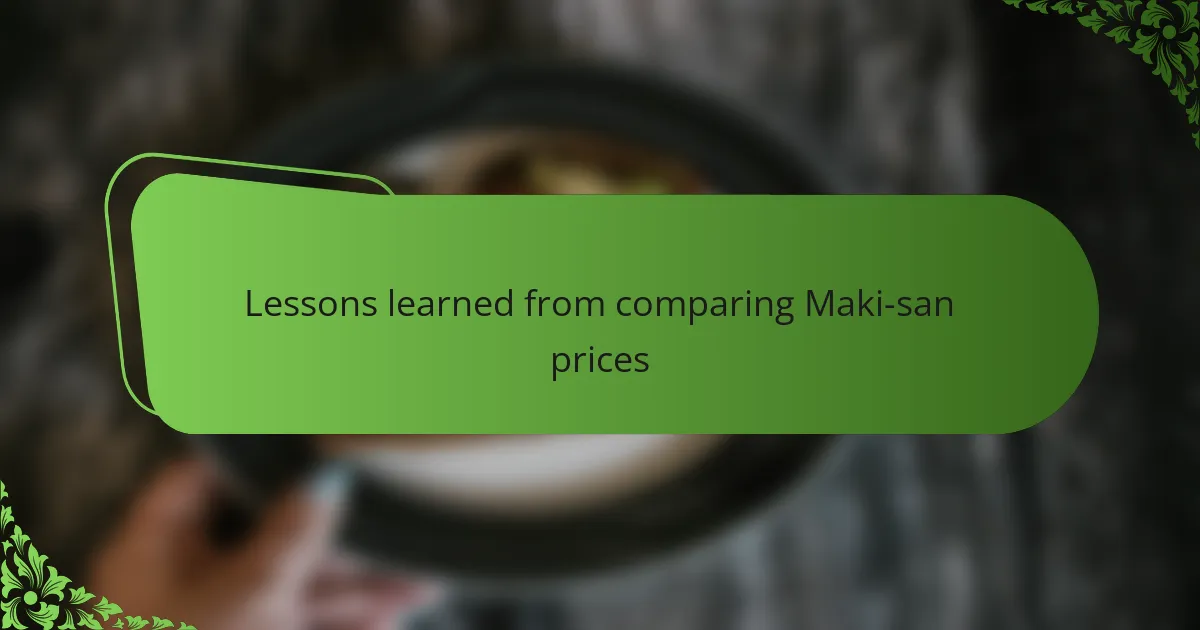
Lessons learned from comparing Maki-san prices
One key lesson I learned from comparing Maki-san prices is that numbers alone don’t tell the full story. I remember spotting a roll that was slightly more expensive at one location but included visibly fresher fish and a generous portion. Have you ever felt disappointed paying less only to see smaller or less vibrant sushi? That moment made me realize value can’t be judged by price tags alone.
Another insight was how location influences pricing, even within the same chain. When I compared Maki-san branches, the differences surprised me—some were noticeably pricier despite offering similar menus. It made me wonder, is it rent, demand, or local competition driving these fluctuations? Understanding this helped me decide where to go based on budget and expectations, rather than assuming all Maki-san spots are equal.
Finally, diving deep into price comparison taught me patience and attention to detail. I often caught myself second-guessing if a slight price gap justified choosing one roll over another. But over time, I learned to trust my sense of when a price felt right for the quality offered. Have you ever struggled with this kind of balance? For me, it turned into a fun challenge rather than a confusing puzzle.

Tips for finding the best sushi deals
One tip I swear by is checking daily specials or lunch menus when hunting for sushi deals. Have you noticed how some places offer tempting discounts during off-peak hours? I once scored incredible toro nigiri at half price just by visiting at midday—it felt like finding treasure.
Another thing I always do is ask restaurant staff about any promotions or combo deals that aren’t obvious on the menu. Sometimes the best offers are hidden or only available if you inquire. It’s a small step that made a big difference in my sushi budget more than once.
Finally, don’t overlook the value of sharing with friends. Splitting a variety of rolls lets me taste more without overspending, and I get to enjoy the experience socially. Have you tried this approach? I find it not only stretches dollars but also turns sushi outings into something more memorable.
